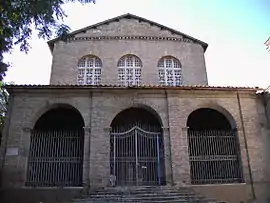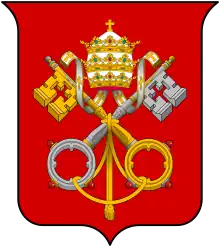Santa Balbina
Santa Balbina is a Roman Catholic basilica church in located in the Aventine rione, adjacent to the Baths of Caracalla in Rome.
| Santa Balbina | |
|---|---|
| Saint Balbina (in English) Sancta Balbina (in Latin) | |
 The façade of Santa Balbina. | |
Click on the map for a fullscreen view | |
| 41°52′50″N 12°29′23″E | |
| Location | Rome |
| Country | Italy |
| Denomination | Roman Catholic |
| History | |
| Status | Titular church |
| Dedication | Balbina of Rome |
| Architecture | |
| Architectural type | Church |
| Groundbreaking | 4th Century |
| Administration | |
| District | Lazio |
| Province | Rome |
| Clergy | |
| Cardinal protector | vacant |
History
A church at the site initially was built in the 4th century over the house of consul Lucius Fabius Cilo. Possibly the ancient Titulus Tigridae, the basilica was consecrated to St Balbina (died c. 130) in circa the year 600 by Pope Gregory I. It underwent many revisions since then, including by Pope Gregory III in 751, Pope Paul II in 1464, and by Cardinal Pompeo Arrigoni in 1600. Initially affiliated with Augustinians, the allegiance changed to the secular priests of Naples by Pope Innocent XII.
The adjoining monastery has a commanding medieval defence tower. Inside the basilica there is a very fine episcopal chair with Cosmatesque decoration from the 13th century. The church was heavily restored in the 1930s when frescoes were discovered on the side walls from the 9th to 14th centuries. The Baroque frescoes in the apse and the triumphal arch were painted by Anastasio Fontebuoni in 1599. The triumphal arch is decorated with the figures of Ss Paul and Peter while in the apse we can see St Balbina between other martyrs.
An ancient sarcophagus was also discovered during the restoration. It is now used as a font.
In 1270 the first known Hungarian cardinal, Stephen Báncsa was buried in the basilica. Another 13th-century Hungarian clergyman, Pál, Bishop of Paphos, erected an altar in the church for Saint Nicolas. Both the altar and the grave disappeared during later centuries, but a plaque commemorates the offerings of Pál.
The most recent cardinal priest of Santa Balbina was Péter Erdő, Archbishop of Esztergom. According to him, the Hungarian connections of the church played a part in the pope's decision to assign him Santa Balbina. Erdö also recommended Hungarian pilgrims visit the basilica and said he feels a special responsibility for the building. In March 2023, his title was changed to Santa Maria Nuova after Santa Balbina was because of its deteriorated physical condition.[1]
Previous titulars include Alfonso de la Cueva, marqués de Bedmar and Francisco Jiménez de Cisneros.
Father Simpliciano of the Nativity founded the Congregation of the Franciscan Sisters of the Sacred Hearts here.
List of Cardinal-Priests
- Guido (attested 1099)[2]
- Vitalis (1111—1116)[3]
- Guido (1116-1119/1120)[4]
- Odalis (1120—1122)[5]
- Gregorio (1125—1139)[6]
- ...
- Simon D'Armentiéres (1294–1297)[7]
- Elzirius de Sabrano (1378–1379)[8]
- Eleazarío da Sabran (18 September 1378–August 1381)[9]
- Bandello Bandelli (19 September 1408-October 1416)[10]
- Guglielmo Carbone (6 June 1411–22 November 1418)[11]
- John Kempe (8 January 1440-21 July 1452)[12]
- Amico Agnifili (13 November 1467-13 October 1469)
- Giovanni Battista Cibò (Pope Innocent VIII) (17 May 1473-January 1474)
- Girolamo Basso Della Rovere (12 December 1477-9 July 1479)
- Juan Margarit I Pau (17 March 1484-21 November 1484)
- Juan de Vera 5 October (1500-4 May 1507)
- Francisco Jiménez de Cisneros, OFM (17 May 1507-8 November 1517)
- Adrian Gouffier de Boissy (1517-1523)
- Giovanni Piccolomini (11 June 1521-24 July 1524)
- Girolamo Ghinucci (31 May 1521-25 January 1524)
- Gasparo Contarini (15 January 1537-9 November 1539)
- Pierpaolo Parisio (28 January 1540-11 May 1545)
- Jacopo Sadoleto (11 May 1545-27 November 1545)
- Otto Truchess von Waldburg (27 November 1545-28 February 1550)
- Pedro Pacheco de Villena (10 March 1550-20 September 1557)
- Lorenzo Strozzi (20 September 1557-14 December 1571)
- Gaspar Cervantes de Gaete (23 January 1572-17 October 1575)
- Gaspar de Quiroga y Vela (15 December 1578-12 November 1594)
- Pompeio Arrigoni (24 January 1597-4 April 1616)
- Antonio Zapata y Cisneros (17 October 1616-27 April 1635)
- Alfonso de la Cueva (9 July 1635-17 October 1644)
- Juan De Lugo y De Quiroga, SJ (17 October 1644-30 August 1660)
- Pascual de Aragón-Cordoba (21 November 1661-28 September 1677)
- Lazzaro Pallavicino (8 November 1677-21 April 1680)
- José Sáenz de Aguirre (10 November 1687-30 August 1694)
- Ferdinando d'Adda (2 January 1696-16 April 1714)
- Antonio Felice Zondadari (23 September 1715-9 April 1731)
- Girolamo Grimaldo (3 September 1731-18 November 1733)
- Thomas Philip Wallard D'Hénín-Liétard D'Alsace-Boussu de Chemay (2 December 1733-17 July 1752)
- Girolamo Spinola (15 February 1760-13 March 1775)
- Alessandro Mattei (27 May 1782-3 April 1786)
- Antonio Felice Zondadari (23 December 1801-13 April 1823)
- Ercole Dandini (16 May 1823-22 July 1840)
- Silvestro Belli (15 July 1841-9 September 1844)
- Giacomo Piccolomini (19 January 1846-4 October 1847)
- Giuseppe Pecci (3 October 1850-21 January 1855)
- Enrico Orfei (18 March 1858-22 December 1870)
- Giuseppe Andrea Bizzarri (5 July 1875-26 August 1877)
- Giacomo Cattani (27 February 1880-14 February 1887)
- Amilcare Malagola (19 January 1893-22 June 1895)
- Donato Maria Dell'Olio (18 April 1901-18 January 1902)
- Auguste-René-Marie Dubourg (7 December 1916-22 September 1921)
- Jean Verdier, PSS (19 February 1929-9 April 1940)
- Clément-Émile Roques (22 February 1946-4 September 1964)
- Léon-Étienne Duval (25 February 1965-30 May 1996)
- Péter Erdő (21 October 2003 - 29 March 2023)
Gallery
 Interior
Interior Santa Balbina in Rome: Coat of arms of Pope Innocent VIII (1473-1474) in the portico
Santa Balbina in Rome: Coat of arms of Pope Innocent VIII (1473-1474) in the portico Bishop's Chair adorned in mosaic by the Cosmati - 13th century
Bishop's Chair adorned in mosaic by the Cosmati - 13th century Crucifixion relief done for the tomb of Pope Paul II by Mino da Fiesole
Crucifixion relief done for the tomb of Pope Paul II by Mino da Fiesole Fortified tower of the Santa Balbina Convent
Fortified tower of the Santa Balbina Convent Opus listatum in the walls of the convent now called Santa Dorotea
Opus listatum in the walls of the convent now called Santa Dorotea Santa Balbina Exterior
Santa Balbina Exterior Santa Balbina, near the Baths of Caracalla
Santa Balbina, near the Baths of Caracalla The way to Santa Balbina
The way to Santa Balbina
References
- "Ferenc pápa új címtemplomot jelölt ki Erdő Péter bíboros számára". Roman Catholic Archdiocese of Esztergom–Budapest. Retrieved 26 June 2023.
- P. Kehr, Archivio della r. Società Romana di storia patria 23 (1900), p. 283. Guido was a genuine cardinal who crossed over to the Obedience of antipope Clement III.
- Hüls, p. 153.
- Hüls, pp. 153-154.
- Hüls, p. 154.
- Hüls, p. 154. Gregorius joined the Obedience of Anacletus II, and was probably one of those deposed and anathematized at the Second Lateran Council.
- Also known as Simon de Caritate. Eubel I, p. 40.
- Eubel I, p. 40. Appointed by Urban VI on 18 September 1378, Elzirius died on 25 August 1380
- Eubel I, p. 40. Bishop of Chieti, he was appointed by Urban VI on 18 September 1378, Elzirius died on 25 August 1380.
- Eubel I, p. 40. Bishop of Rimini.
- Eubel I, p. 40. Bishop of Chieti.
- Eubel II, p. 61. Kempe was Archbishop of York.
Bibliography
- Eubel, Conradus, ed. (1913). Hierarchia catholica (in Latin). Vol. Tomus 1 (second ed.). Münster: Libreria Regensbergiana.
- Eubel, Conradus, ed. (1914). Hierarchia catholica (in Latin). Vol. Tomus 2 (second ed.). Münster: Libreria Regensbergiana.
- Eubel, Conradus (ed.); Gulik, Guilelmus (1923). Hierarchia catholica (in Latin). Vol. Tomus 3 (second ed.). Münster: Libreria Regensbergiana.
{{cite book}}:|first1=has generic name (help) - Gauchat, Patritius (Patrice) (1935). Hierarchia catholica (in Latin). Vol. Tomus IV (1592-1667). Münster: Libraria Regensbergiana.
- Ritzler, Remigius; Sefrin, Pirminus (1952). Hierarchia catholica medii et recentis aevi (in Latin). Vol. Tomus V (1667-1730). Patavii: Messagero di S. Antonio.
- Ritzler, Remigius; Sefrin, Pirminus (1958). Hierarchia catholica medii et recentis aevi. Vol. Tomus VI (1730-1799). Patavii: Messagero di S. Antonio.
- Ritzler, Remigius; Sefrin, Pirminus (1968). Hierarchia Catholica medii et recentioris aevi (in Latin). Vol. VII (1800–1846). Monasterii: Libreria Regensburgiana.
- Remigius Ritzler; Pirminus Sefrin (1978). Hierarchia catholica Medii et recentioris aevi (in Latin). Vol. VIII (1846–1903). Il Messaggero di S. Antonio.
- Hüls, Rudolf (1977). Kardinäle, Klerus und Kirchen Roms: 1049–1130 (in German). Bibliothek des Deutschen Historischen Instituts in Rom. ISBN 978-3-484-80071-7.
External links
- Nyborg, Chris, "Santa Balbina".
- Lucentini, M. (31 December 2012). The Rome Guide: Step by Step through History's Greatest City. Interlink. ISBN 9781623710088.
![]() Media related to Santa Balbina at Wikimedia Commons
Media related to Santa Balbina at Wikimedia Commons
| Preceded by Santi Apostoli, Rome |
Landmarks of Rome Santa Balbina |
Succeeded by San Bartolomeo all'Isola |
